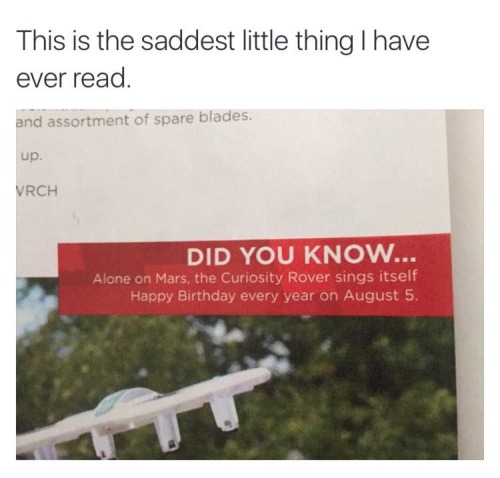Latest Posts by dotmpotter - Page 3
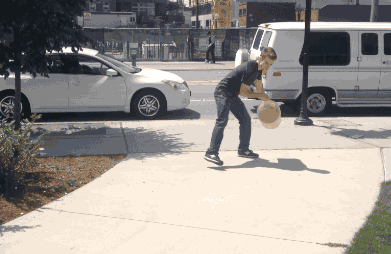
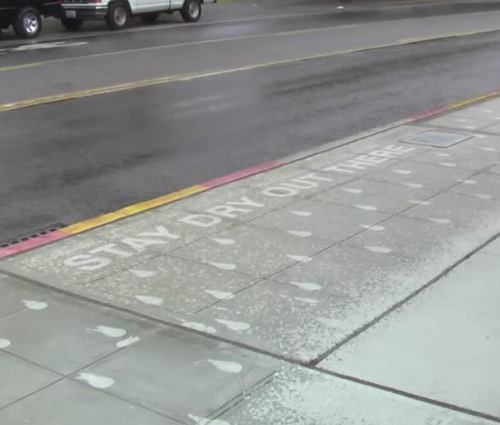
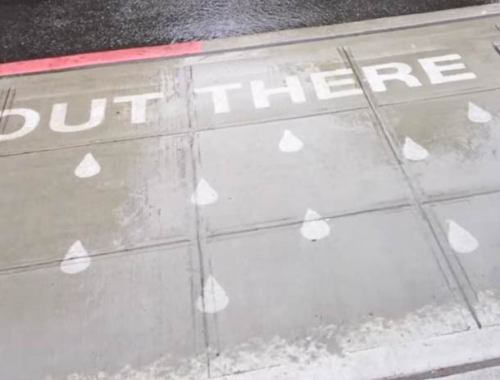
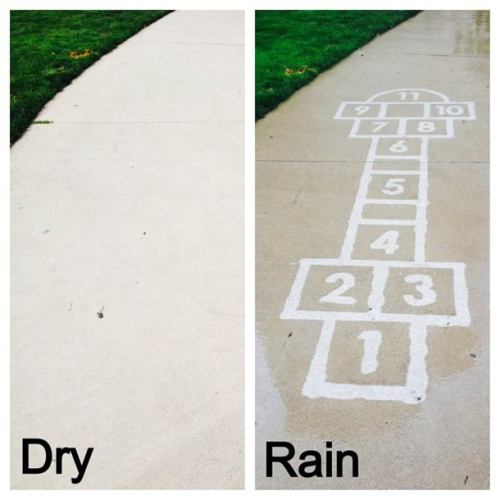
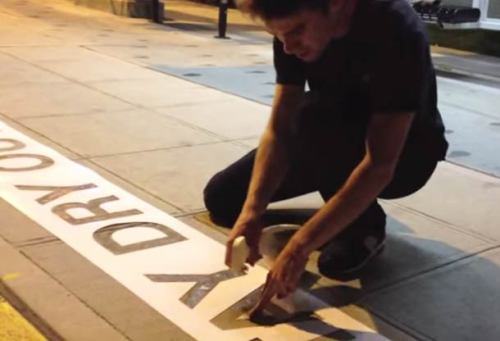
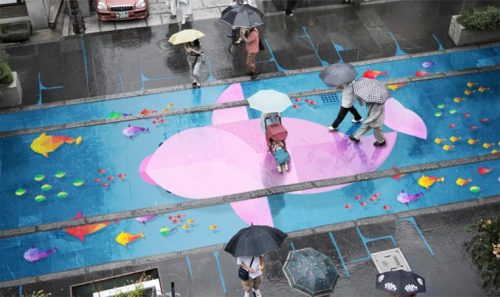
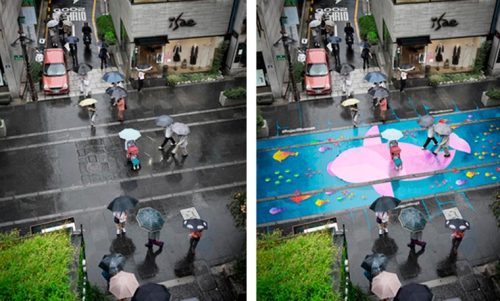
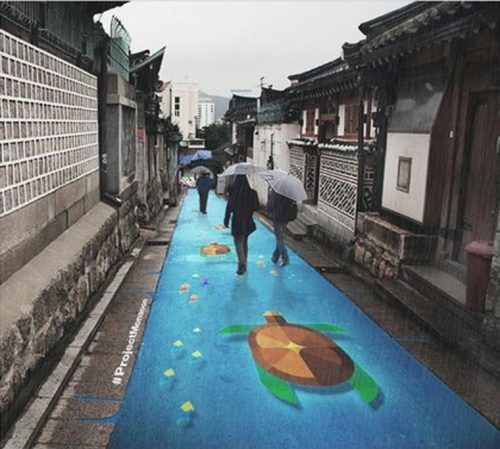
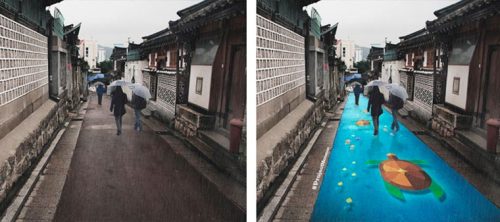
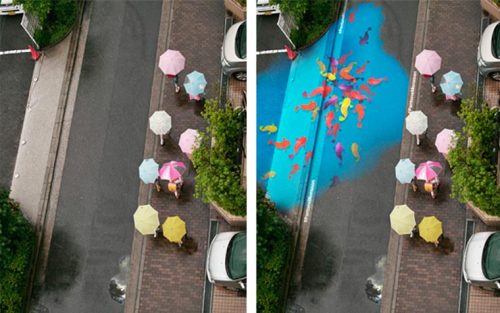
Project Monsoon Clever colorful street art that only appears when it rains
After the Superhydrophobic Street Art, which uses a superhydrophobic coating to create designs which appear only in the rain, here is the Project Monsoon, which uses the same concept, this time with hydrochromic painting, which reveals its color only when wet. This amazing and clever project was designed by a Korean team of designers, in collaboration with Pantone, to provide color to the streets of Seoul during the rainy season, while paying tribute to the Korean culture. A brilliant idea! Source: ufunk
The Scripps CO2 measurements at the Mauna Loa Observatory on the big island of Hawaii have shown that atmospheric carbon dioxide (CO2) levels climbed above the 400 parts per million (ppm). Because CO2 stays in the atmosphere for a very long time, some scientists say for millennia, our global fever has reached the point that no one alive today, and those that follow us, will ever know a world below 400 ppm again.
This week will be the last time anyone alive experiences a CO2 level below 400 ppm. (Saturday Nov 21, 2015)







Coating Makes Steel Tougher, Keeps Microbes From Sticking
More and more objects are getting superhydrophobic coatings that make liquids bounce right off. Surfaces with complex nanoscopic structures that prevent wetting will soon be deployed on wind turbine blades and aircraft wings to prevent ice from sticking, and even concrete is being doped with superhydrophobic compounds to help it last decades longer.
Much still needs to be done, though, to strengthen these coatings because any damage can remove the ability to repel liquids. Such an advance is hugely important since there are potentially life-saving healthcare applications if this hurdle could be overcome with a stable, nontoxic coating for steel. Just imagine if implants, scalpels and other tools used on patients had a surface impossible for infection-causing microbes to cling to.
Now, Joanna Aizenberg and her colleagues at Harvard’s Wyss Institute for Biologically Inspired Engineering have demonstrated a possible solution. They’ve been able to coat stainless steel with nanoporous tungsten oxide, which repels all liquids. What’s more, the surface is extremely tough, maintaining superhydrophobicity even after being scratched with sharp steel objects and diamond.
Keep reading

Now that is pure adaptation!
As the days get darker and colder in much of the northern hemisphere, it’s easy to indulge in gloom. For the next few months, you’ll be shivering. You’ll be battling foul weather. Thanks to daylight saving time there will be no chance to see the sun after work.
The gloom leads to a common question: What can I do to cope with the dark and cold?
If you truly want to be happy during winter, though, this is the wrong approach to the season. Changing your mindset can do more than distracting yourself from the weather.
At first, she was asking “Why aren’t people here more depressed?” and if there were lessons that could be taken elsewhere. But once she was there, “I sort of realized that that was the wrong question to be asking,” she says. When she asked people “Why don’t you have seasonal depression?” the answer was “Why would we?”
It turns out that in northern Norway, “people view winter as something to be enjoyed, not something to be endured,” says Leibowitz, and that makes all the difference.
Lessons From The Far North
To be sure, there are some aspects of the near-polar culture that might be hard to emulate elsewhere. Small Norwegian communities are tightly knit, and strong social ties increase well-being everywhere. That said, there are lessons that can help anyone think differently about cold weather.
When’s the last time you thought about the revolving door? This modest invention—something you likely encounter with a sense of dread while rushing off to the office or airport—is something of a modern miracle. Every time a revolving door rotates, it generates enough electricity to power a 60-watt light bulb for 23 minutes, equalizes indoor temperatures, and reduces carbon output—ultimately slowing climate change.
Revolving Doors Are an Energy Powerhouse. Why Don’t We Use Them? | GOOD
Ubiome is an unusual startup. The three-year-old sequences the collected microbes in the human body and sells $89 kits to those curious to understand their own microbiome better. Now uBiome founders and academics Jessica Richman and Zachary Apte — who’ve raised $6.5 million from investors like Andreessen Horowitz for the San Francisco company — are taking an even more unusual step. They’re launching an AngelList Syndicate to fund other microbiome startups.
uBiome’s Founders Launch A Microbiome Syndicate on AngelList | TechCrunch

G20 Governments collectively handed out $452bn in subsidies for fossil fuels in both 2013 and 2014 - four times the amount allocated globally for renewables.
(via Fossil fuels receive four times as many subsidies as renewables, report finds)
Ending slavery will also help save the one thing that connects us all... Earth.

Read it here.
“Desperate migrants from Myanmar and Cambodia are enslaved on fishing boats to strip the oceans of fish… in Brazil, young men are trapped by debt in work illegally logging the Amazon forest… Brick kilns in India, operated by bonded labourers, are fuelled with old tyres and used motor oil, spewing carcinogens into the air.”
REBLOG to educate your community about the impact of our everyday consumption.

Antibiotic resistance is one of the biggest threats to global health today.
It is compromising our ability to treat infectious diseases and undermining many advances in health and medicine. This can affect anyone in any country, and is not just a problem for regular antibiotic users.
Look at the causes and tips provided by the World Health Organization (WHO) to find out what you can do.
How much do you know about #AntibioticResistance? Take this quiz: http://goo.gl/3FRuKQ
That is the course that world leaders set when they met at the United Nations in New York on September 25 to adopt the Sustainable Development Goals (SDGs). The 17 goals range from ending poverty and improving health to protecting the planet’s biosphere and providing energy for all. They emerged from the largest summit in the UN’s history, the “Rio+20” conference in 2012, followed by the largest consultation the UN has ever undertaken.
We need your help to sustain our not-for-profit mission: ensuring that readers around the world have equal access to ideas and analysis from the world’s leading thinkers.
Unlike their predecessor, the Millennium Development Goals, which focused almost exclusively on developing countries, the new global goals are universal and apply to all countries equally. Their adoption indicates widespread acceptance of the fact that all countries share responsibility for the long-term stability of Earth’s natural cycles, on which the planet’s ability to support us depends.
Johan Rockstrom goes all in on poverty reduction and climate change.
How To Avoid The Next Atlantis
They say nothing in life is guaranteed except death and taxes. Maybe we should add rising sea levels to that list?
The lapping waves of Earth’s oceans are going to move as much as 1 full meter higher within our lifetimes, and perhaps several meters more in the coming centuries depending on what we do or don’t do about slowing down climate change. Part of this comes from melting glaciers and ice shelves flowing out to sea, and part comes from the natural expansion of water as it warms, but we have to face facts: Sea level is rising.
This new video from MinuteEarth looks at some of the interesting ways that coastal cities around the globe are trying to get ready for a wetter world. I wish this wasn’t something we had to prepare for, but I’m glad we’ve got smart people on the job.
Bonus: Curious what 1 meter of sea level rise looks like? Head over to Climate Central and play with their Surging Seas map simulator. Look, you can even make half of Florida and Louisiana disappear!


So, a new plant related to the potato is being named after Mark Watney and this makes me very happy.

“My lab group has decided to name this new species Solanum watneyi after Mark Watney, the book/film character who shows us all that botanists can be cool, too.” - Dr. Chris Martine, Professor at Bucknell University
On a fossil-hunting trip with her family, five-year-old Daisy Morris found the remains of a previously undiscovered dinosaur, which is now named Vertidraco daisymorrisae. The new dino is not only a previously unknown species, but an unknown genus, making Daisy’s find a really big deal. It’s a pterosaur — a winged flying dino — about the size of a crow, which lived 115 million years ago.
Can an army of voluntary "mappers" (like you) help end child slavery on Lake Volta, Ghana?



LEARN MORE about being a “mapper” here.
Consider a 100% tax-deductible DONATION to free a child from slavery on Lake Volta here: madeinafreeworld.com/ghana
The problem comes from people whose opinions are actually misconceptions. If you think vaccines cause autism you are expressing something factually wrong, not an opinion. The fact that you may still believe that vaccines cause autism does not move your misconception into the realm of valid opinion. Nor does the fact that many other share this opinion give it any more validity… You can be wrong or ignorant. It will happen. Reality does not care about your feelings. Education does not exist to persecute you. The misinformed are not an ethnic minority being oppressed. What’s that? Planned Parenthood is chopping up dead babies and selling them for phat cash? No, that’s not what actually happened. No, it’s not your opinion. You’re just wrong.
Yes, Your Opinion Can Be Wrong | Houston Press
This whole article.
Education does not exist to persecute you.
(via witch-boots)

Trident is a remote-controlled, camera-equipped underwater drone – and it’s the fastest machine yet from underwater robotics startup OpenROV. It can go as fast as Michael Phelps.
The underwater drone can stream live video to a monitor during explorations and the team at OpenROV is currently exploring VR so those playing with one of these drones can feel like they are right there in the depths with their vehicle.
Check out the video here!
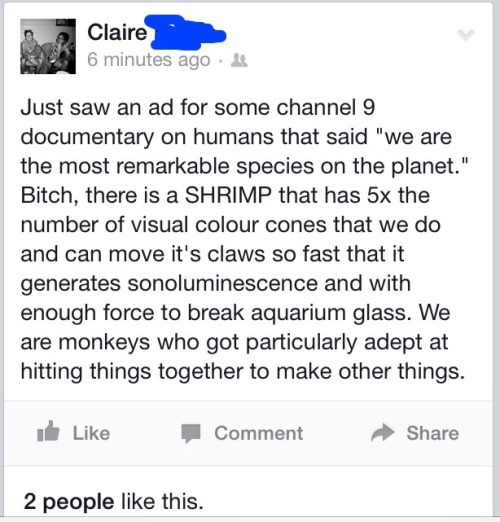
I am not here for the idea that humans > everything else.
Basic income is a tested social vaccine. It’s been found to increase equity and general welfare. It has been found to reduce hospitalizations by 8.5% in just a few years through reduced stress and work injuries. It’s been found to increase birth weights through increased maternal nutrition. It’s been found to decrease crime rates by 40% and reduce malnourishment by 30%. Intrinsic motivation is cultivated. Students do better in school. Bargaining positions increase. Economic activity increases. Entrepreneurs are born. With experiment after experiment, from smaller unconditional cash transfers to full-on basic incomes, the results point in positive directions across multiple measures when incomes are unconditionally increased.
Universal Basic Income as the Social Vaccine of the 21st Century (via letseyx)
It’s almost as if, as a species, we didn’t need to hurt ourselves in order for life to go on.
(via imathers)

Could Europe Be Powered by African Solar Energy?
For a long time, people looking for big fixes to climate change have been talking about building huge solar installations in North Africa, which gets a lot more sun than most of the places where solar power is big — Germany, for example. But now, it looks as if someone finally is doing it.
Next month in Ouarzazate, Morocco, the first portion of what eventually will be the world’s biggest concentrated solar power plant – called Noor I – is set to go online, according to the Guardian, a British newspaper.
Eventually, when the entire $10 billion complex, which is being financed with assistance from the World Bank and European Union, is completed in 2020, it will generate 580 megawatts of electricity, enough to provide a big portion of Morocco’s energy needs while still leaving plenty of juice for export. The complex could prevent 700,000 tons of carbon dioxide from being spewed into the atmosphere each year.
The plant uses an ingenious technology for getting the most out of sunlight. A huge array of 500,000 crescent-shaped mirrors focus sunlight and transmit it to a single point on a tower. (The mirrors actually have tiny computers in them, which adjust the angle throughout the day to gather the most energy.)
The plant could turn Morocco, which depends upon fossil fuel imports to fill 94 percent of its energy needs, into a major producer of electricity for export. Find out how by clicking here.

The New England Climate Adaptation Project (NECAP) got local citizens and officials in four coastal towns to engage in role-playing games about climate change tailored to their communities, while conducting local polling about attitudes and knowledge about climate risks. In so doing, the project helped the towns reach new conclusions about local initiatives to address the threats posed by climate change— which in coastal communities may include rising sea levels and increased storm surges that can lead to flooding.
“One hour of conversation can completely alter people’s sense [and show] that this is a problem they can work on locally,” says Lawrence Susskind, the Ford Professor in Urban Studies in MIT’s Department of Urban Studies and Planning (DUSP), who led the project and has now co-authored a new book detailing its results. “There are a bunch of things local governments can do, and people can do for themselves — that communities can do.”
The findings stem from years of research and organizing in four places: Wells, Maine; Dover, New Hampshire; Barnstable, Massachusetts; and Cranston, Rhode Island. The new book on the effort, “Managing Climate Risks in Coastal Communities,” has just been released by the academic publisher Anthem Press.
Among the many findings of the project is that residents of these coastal communities were typically far more concerned about the consequences of climate change than local politicians realized.
Citizen Maths: free/open adult math education for practical real-world numeracy

Without scientific understanding, we don’t run the government, the government runs us” -Carl Sagan, in his final interview.
Last week we released a big batch of new CC-BY licensed content for Citizen Maths a free online course for adults who want to improve their grasp of maths at what in the UK is known as Level 2 (the level that 16 year old school leavers are expected to reach, though many do not).
(Image: Jonathan Worth, CC BY-SA 4.0)
The new course content covers the powerful ideas in maths of “uncertainty” and “representation”. It sits alongside the content for “proportion” which was published last year.
Learning about each idea is supported by a mix of short video tutorials, practical exercises, and quizzes. The practical exercises use a range of approaches including:
* tools like spreadsheets;
* purpose-built self-standing “apps” of various kinds;
* coding in Scratch.
Each powerful idea is shown in action in several different contexts. For example, “uncertainty” involves the following situations:
* Making decisions — value of insurance, risk comparisons;
* Judging — the meaning of cancer screening results;
* Gaming — appreciating odds in roulette, dice, horse-racing;
* Modelling — the uncertain prediction of the weather.
The powerful ideas and the situations in which they are shown in action have been selected in consultation with maths teachers, and with organisations familiar with the learning needs of adults.
http://boingboing.net/2015/11/03/citizen-maths-freeopen-math.html

Map of Australia with a so called ‘remoteness index’, illustrating how far locations in Australia are from population centers [999x766] CLICK HERE FOR MORE MAPS! thelandofmaps.tumblr.com

New Guinea is one of the most linguistically diverse places in the world, with more than 1000 distinct languages crammed into an area not much larger than the state of Texas.
Despite this rich variety—for comparison, Europe contains about 280 languages—linguists have only analyzed the grammatical structures of a fraction of the South Pacific island’s languages. Now, Simon Greenhill, a linguist at Australian National University in Canberra, is trying to remedy that situation, by gathering together hundreds of thousands of words from published surveys, book chapters, and articles, as well as the accounts of early European explorers, and putting them into an online database called TransNewGuinea.org.
Updated daily, the site already contains glossaries for more than 1000 languages from 23 different language families, including 145,000 words. There are roughly 1000 different words for “water,” as well as for “louse,” and linguists and language enthusiasts can view all the languages by geographic origin in an interactive map.
Greenhill introduced the scientific community to the site(PDF) this week in the journal PLOS ONE; already, he has used the database to look for clues about how the different languages are related. Through comparative, historical, and computational analyses of the data, he hopes the linguistic community will now use the site to solve long-standing questions about how New Guinean populations expanded and spread their culture.
This came across my desk this morning in the course of philanthropic research, and it’s a fascinating portrait primarily of the head of a charitable organization that serves his own community (the blind and visually impaired) but also a mixed-message reconstruction of a man who mysteriously bequeathed $125M – fifteen times the charity’s operating budget – to an organization that never knew his name.
(A more-or-less transcript of the podcast is also available below the player.)
No amount of multivitamins, yoga, meditation, sweaty exercise, superfoods or extreme time management, as brilliant as all these things can be, is going to save us from the effects of too much work. This is not something we can adapt to. Not something we need to adjust the rest of our lives around. It is not possible and it’s unethical to pretend otherwise. Like a low-flying plane, the insidious culture of overwork is deafening and the only way we can really feel better is if we can find a way to make it stop.
No, it’s not you: why ‘wellness’ isn’t the answer to overwork (via brutereason)

Check in: The Tokyo hotel where guests can curl up with 1,700 good books
Book and Bed, a new Tokyo hotel, has created the sort of space that is impossible to leave. It is a cheap and cheerful dorm with a difference: guests’ bunk beds are hidden behind library shelves filled with hundreds of books in Japanese and English. | Read more




The Moon Parka - A jacket made of synthetic spider silk
Remember the Japanese biomaterials company Spiber? In 2013, they presented a cocktail dress made of Qmonos (from the Japanese word kumonosu meaning ‘spider web’), their present 11-year-10-design-iterations-and-656-gene-synthesis synthetic version of stronger than steel and more flexible than nylon lightweight spider silk.
Snip from geek.com:
The end result of all that research is a method for producing artificial spider silk through a fermentation process using bioengineered microorganisms to produce the silk proteins. A real spider can only produce so much silk, but an engineered cell that does nothing but spit out silk proteins can be used to scale production up quickly.
Now they presented in collaboration with The North Face a new prototype called The Moon Parka, which is currently touring North Face stores across Japan. It’s intended to show that practical applications of spider silk are possible (cost is now 1/53,000 of what it was in 2008). Spiber aims to deliver the final product next year. Presumably only in Japan. But fingers crossed for a worldwide rollout at reasonable prices.
Watch their promo-launch video below:
[North Face x Spiber] [Spiber] [picture by North Face]
